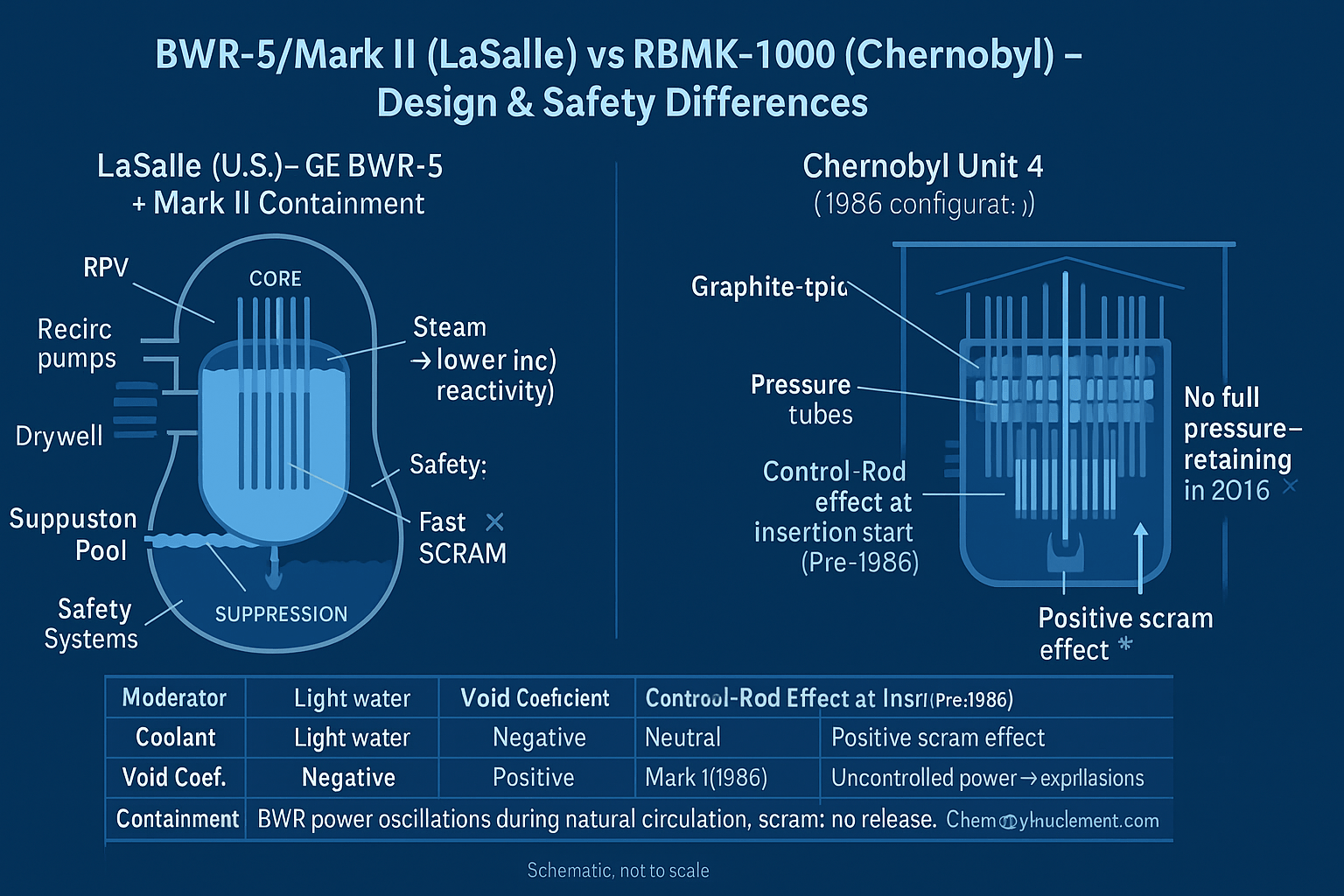
Quick summary
What happened at LaSalle (Illinois, USA): On March 9, 1988, LaSalle Unit 2 (a GE BWR-5 with Mark II containment) tripped both recirculation pumps and entered power oscillations during natural circulation. Operators scrammed the reactor; no public hazard occurred. The NRC treated it as a significant stability and operations lesson for all BWRs.
Why this was not “another Chernobyl”: LaSalle’s reactor physics, containment, and procedures differ fundamentally from Chernobyl’s RBMK design (graphite-moderated, positive void coefficient, no full pressure-retaining containment). U.S. plants have robust containments and shutdown systems designed to keep fission products inside, even in severe accidents.
What happened at LaSalle in 1988
The LaSalle nuclear incident: what actually occurred
Plant & design. LaSalle Units 1–2 are boiling water reactors (BWR-5) built by GE with Mark II (wet) containment. Licensed thermal power ~3546 MWt.
Event timeline (March 9, 1988).
- Dual recirculation-pump trip at Unit 2.
- The reactor, now on natural circulation, experienced excessive neutron-flux/power oscillations (a known BWR stability phenomenon under certain low-flow/low-power conditions).
- Operators scrammed (rapid shutdown).
- NRC issued Information Notice 88-39 and follow-on generic actions to brief operators and review stability controls fleet-wide. Nuclear Regulatory Commission+2Nuclear Regulatory Commission+2
Technical takeaway. The event spotlighted BWR thermal-hydraulic instability: under specific states, small changes in steam (voids) can modulate reactivity, causing oscillations. Modeling and AIT reports dissected causes and operator response to strengthen training, procedures, and plant configurations. OSTI+1
BWR-5/Mark II vs. RBMK: side-by-side
| Feature | LaSalle (BWR-5) | Chernobyl Unit 4 (RBMK-1000) |
|---|---|---|
| Moderator | Light water (also coolant) | Graphite moderator, light-water coolant |
| Void coefficient | Negative (voids reduce reactivity) | Large positive (voids increase reactivity) — a key hazard |
| Containment | Mark II pressure-retaining containment (drywell + suppression pool) | No Western-style full pressure containment |
| Control rods | Bottom-entry BWR rods; rapid scram inserts strong negative reactivity | Original design had graphite displacers; initial insertion added positive reactivity (“positive scram effect”) |
| Operating culture & rules | U.S. NRC licensing, operator training, emergency planning, PRA-informed mods | 1986 test violated safety rules; inadequate safety culture & oversight |
Why this matters: In a BWR like LaSalle, more steam bubbles in the core tend to shut the reaction down (negative feedback). In an original RBMK, more steam could spur the reaction (positive feedback), which—combined with disabled safety systems and a flawed late-night test—contributed directly to the runaway reactivity and explosions at Chernobyl.
How close was LaSalle to a Chernobyl-style meltdown?
Short answer: Not close.
- The physics (negative void coefficient) make BWR oscillations self-limiting compared to RBMK behavior under the same stimulus.
- LaSalle had rapid scram, automatic trips, and Mark II containment to keep radioactivity in if fuel damage occurred.
- NRC’s post-event reviews and fleet-wide actions treated this as a stability-control and training issue—not an imminent core-disassembly or containment-bypass threat.
That said, the event was serious operationally and spurred improvements across BWRs. Modeling/inspections deepened understanding of natural-circulation stability and operator cues/controls, which is exactly how a mature safety regime is supposed to work.
Post-event improvements in U.S. BWRs
Post-Chernobyl & post-LaSalle lessons (for the U.S. fleet)
After Chernobyl (1986): U.S. regulators emphasized differences in design and strengthened severe-accident management, international information sharing, and exercises. The NRC’s “Chernobyl backgrounder” highlights how design & containment differences and broader safe-shutdown capabilities protect U.S. plants. Nuclear Regulatory Commission
After LaSalle (1988):
- NRC briefings, bulletins, and generic letters required operator training on oscillation recognition, stability maps/controls, recirc-pump trip responses, and hardware/procedure updates as needed. Nuclear Regulatory Commission+1
- National labs and the IAEA community studied BWR stability extensively, refining models and guidance. International Nuclear Information System
- PRA studies for LaSalle (fire, seismic, external events) quantified core-damage frequencies and fed back into maintenance and risk-informed decision-making.
Key differences that prevented a LaSalle-to-Chernobyl outcome
- Containment architecture (Mark II) designed to limit releases in postulated LOCAs and transients.
- Negative reactivity feedback in BWRs makes unstable oscillations easier to arrest via scram/flow changes versus RBMK’s historic positive feedback.
- Regulatory culture: independent NRC oversight, conservative operator training, and fleet-wide dissemination of operating experience (OE).
FAQ
Did LaSalle release radiation during the 1988 event?
Publicly available NRC documents discuss the instability and scram; they do not characterize it as a radiological emergency. The focus was on stability controls and training, not public dose.
What exactly is a “BWR power oscillation”?
At low flow/low power, coupled thermal-hydraulic/neutronic feedback can cause reactor power to cycle. Operators are trained to recognize cues and scram or restore stable conditions.
Is LaSalle’s Mark II containment robust?
Yes. It’s a pressure-retaining containment (drywell + suppression pool) engineered for LOCA pressure/temperatures and to limit releases—a fundamental difference from the RBMK at Chernobyl.
References & further reading
- NRC: “Power Oscillations in BWRs” & Information Notice 88-39 (LaSalle U2 event & required briefings). Nuclear Regulatory Commission+1
- NRC plant page – LaSalle Unit 2: Reactor type GE BWR-5, Mark II containment. Nuclear Regulatory Commission
- GE BWR & Mark II history (overview). Wikipedia
- NRC Backgrounder on Chernobyl (U.S. design differences & protections). Nuclear Regulatory Commission
- World-Nuclear RBMK (design features & known issues). World Nuclear Association
- Lab/NRC analyses of LaSalle stability (BNL/Sandia/INIS papers). OSTI+2OSTI+2